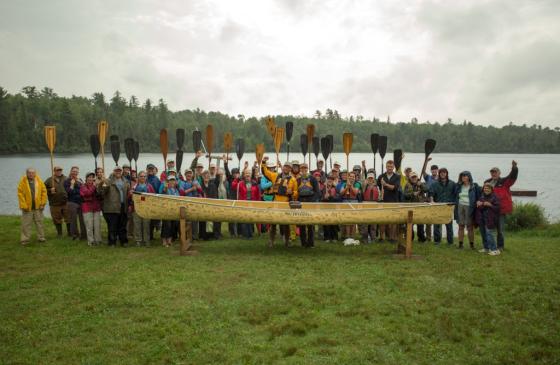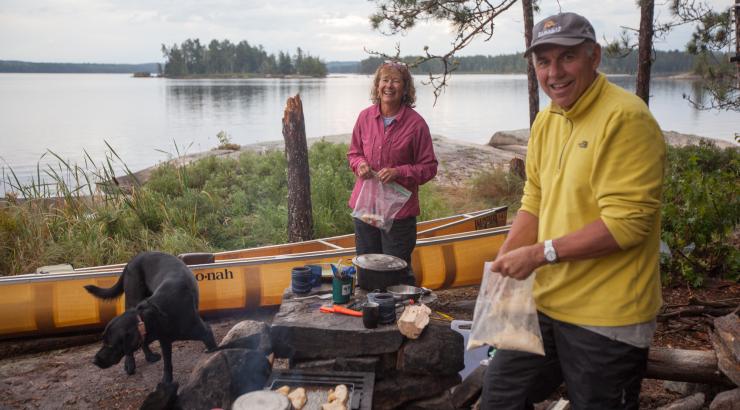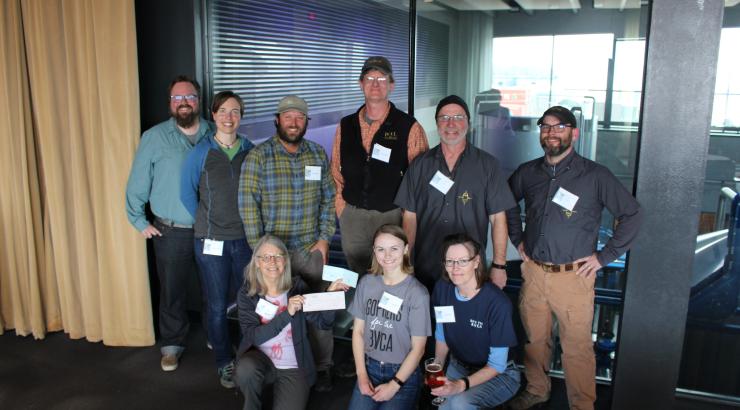On a rainy day in late August my wife Amy and I climbed into our canoe and paddled away from the Voyageur Outward Bound School in Northern Minnesota. About 50 people came out to paddle the first mile of the Kawishiwi River with us as we followed the path of pollution from the proposed Twin Metals mine into our nation's most popular wilderness, the Boundary Waters Canoe Area in Northern Minnesota. The goal of our journey was to celebrate the 50th anniversary of the Wilderness Act and rally support for the Boundary Waters to protect it from a series of proposed sulfide ore mines on the edge of the Boundary Waters. 101 days later many of the same Minnesotans huddled together in the freezing rain and climbed into canoes to paddle with us for the final stretch of our 2,000 mile journey by water from the Boundary Waters to Washington D.C. Our Wenonah Canoe, Sig, had gained several thousand signatures and a couple of scratches along the way. Through out the journey we did over 50 interviews with a wide range of local, regional and national media outlets, met directly with close to 3,000 people during 40 events along our route, portaged nearly 100 miles and dipped our paddles over 3 million times into dozens of waterways, from pristine Boundary Waters lakes to Superfund Sites along the East Coast.
Several dozen people came out in the pouring rain to welcome us when we paddled into the Washington Canoe Club on December 2nd. We have compiled a few of our favorite images as well as a short video the distills Paddle to DC and the threats the Boundary Waters face into 8 minutes.
Paddle to DC: A Quest for Clean Water from Nate Ptacek on Vimeo.
A photo posted by Save The Boundary Waters (@savethebwca) onOct 10, 2014 at 1:17pm PDT
There were really 4 of us on this journey, Olivia Ridge (our project manager), Sig the canoe, Amy Freeman and me (Dave Freeman).
We followed the path of pollution from the proposed Twin Metals Mines site on Birch Lake down the Kawishiwi River into the Boundary Waters and spent 8 days paddling through the Boundary Waters to reach Lake Superior at Grand Portage.
A photo posted by Nate Ptacek (@arborealis) onSep 9, 2014 at 4:14pm PDT
We spent 3 weeks sailing across Lake Superior and Georgian Bay, stopping in towns in Minnesota, Wisconsin, Michigan and Ontario to give presentations and share our story.
Edward Abbey said,"The idea of wilderness needs no defense, it only needs defenders." Our goal was to gather more defenders for the Boundary Waters from communities in Northern Minnesota and across the country through events like this one at the Patagonia store in Washington D.C., media coverage, blogging and social media.
A photo posted by Dave and Amy Freeman (@freemanexplore) onSep 9, 2014 at 5:52pm PDT
During the first 80 days we camped most of the time. We usually found beautiful campsites along the waterways we traversed like this one on the French River in Ontario. We left our sailboat near the mouth of the French River in Georgian Bay. We would spend the last 2 months traveling about 1,300 miles by canoe.
We encountered many beautiful places, like the Mattawa River in Ontario, but none were quite like the Boundary Waters, where we still dip our cups in the middle of the lake when we are thirsty.
A photo posted by Dave and Amy Freeman (@freemanexplore) onOct 10, 2014 at 7:36am PDT
There was a lot of portaging, including 3 portages that were 15 to 30 miles long. We used our cart to traverse some pretty urban areas and connect an unusual network of waterways on our way to Washington D.C. The portaging gave us a chance to meet more people; lots of people stopped us ask what we were doing and many of them wanted to sign Sig and our petition to protect the Boundary Waters.
As the weather got colder more people invited us to stay with them as we past through more urban areas between New York City and the Nation's capitol.
A photo posted by Save The Boundary Waters (@savethebwca) onDec 12, 2014 at 2:29pm PST
Sig toured the Capitol and portaged past the White House. Chief Tidwell, the head of the US Forest Service, accepted Sig, our canoe, on behalf of the administration and the Sig is being displayed at the Forest Service Headquarters in DC so that more people will be able to learn about our journey and the Boundary Waters.
40 Minnesotans joined us in D.C. We spent 3 days meeting with elected officials and government agencies to educate them about the sulfide ore mines that are being proposed on the edge of the Boundary Waters and share our concerns. We have hung up our paddles for the moment, but our work to save the Boundary Waters from copper mines in a sulfide ore body has just begun. Please learn more about this important issue, sign the petition and join the movement. The Boundary Waters belongs to all of us and it is up to us to protect it. Dozens of people opened their homes to us, organized events and supported us physically and emotionally along the way. Hundreds more donated time and money through the Save the Boundary Waters Campaign to help make Paddle to DC a success.
Thank you for all of your support. Paddles Up!
Dave and Amy Freeman


